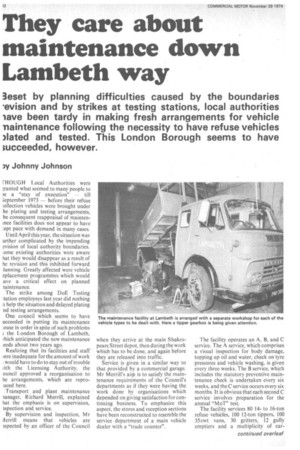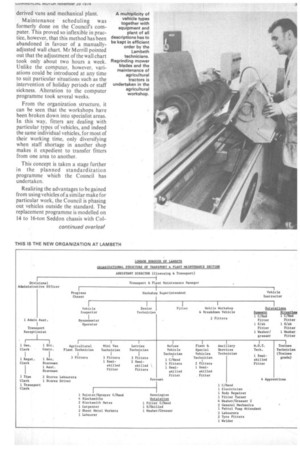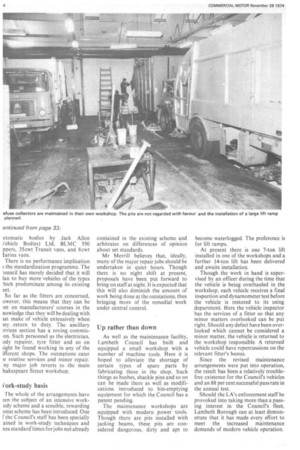They care about maintenance down Lambeth way
Page 34

Page 35

Page 36

If you've noticed an error in this article please click here to report it so we can fix it.
3eset by planning difficulties caused by the boundaries .evision and by strikes at testing stations, local authorities lave been tardy in making fresh arrangements for vehicle naintenance following the necessity to have refuse vehicles )Iated and tested. This London Borough seems to have ;ucceeded, however.
ri Johnny Johnson
THOUGH Local Authorities were ;ranted what seemed to many people to )e a "stay of execution" till ;eptember 1973 — before their refuse ;ollection vehicles were brought under he plating and testing arrangements, he consequent reappraisal of maintenLnce facilities does not appear to have :ept pace with demand in many cases. Until April this year, the situation was arther complicated by the impending evision of local authority boundaries. orrie existing authorities were aware at they would disappear as a result of he revision and this inhibited forward lanning. Greatly affected were vehicle eplacement programmes which would ave a critical effect on planned laintenance.
The strike among DoE Testing tation employees last year did nothing help the situation and delayed plating nd testing arrangements.
One council which seems to have ueceeded in putting its maintenance ouse in order in spite of such problems ; the London Borough of Lambeth, rhich anticipated the new maintenance eeds about two years ago.
Realizing that its facilities and staff lere inadequate for the amount of work would have to do to stay out of trouble pith the Licensing Authority, the ouncil approved a reorganisation to he arrangements, which are reprouced here.
Transport and plant maintenance lanager, Richard Merrill, explained at the emphasis is on supervision, lspection and service.
By supervision and inspection, Mr derrill means that vehicles are ispected by an officer of the Council when they arrive at the main Shakespeare Street depot, then during the work which has to be done, and again before they are released into traffic.
Service is given in a similar way to that provided by a commercial garage. Mr Merrill's aim is to satisfy the maintenance requirements of the Council's departments as if they were having the work done by organisations which depended on giving satisfaction for continuing business. To emphasize this aspect, the stores and reception sections have been reconstructed to resemble the service department of a main vehicle dealer with a "trade counter". The facility operates an A, B, and C service. The A service, which comprises a visual inspection for body damage, topping up oil and water, cheek on tyre pressures and vehicle washing, is given every three weeks. The B service, which includes the statutory preventive maintenance check is undertaken every six weeks, and the C service occurs every six months, it is obvious that each second C service involves preparation for the annual "MoT" test.
The facility services 80 14to 16-ton refuse vehicles, 100 12-ton tippers, 100 35 cwt vans, 30 gritters, 12 gully emptiers and a multiplicity of car derived vans and mechanical plant.
Maintenance scheduling was formerly done on the Council's computer. This proved so inflexible in practice, however, that this method has been abandoned in favour of a manuallyadjusted wall chart. Mr Merrill pointed out that the adjustment of the wall chart took only about two hours a week. Unlike the computer, however, variations could be introduced at any time to suit particular situations such as the intervention of holiday periods or staff sickness. Alteration to the computer programme took several weeks.
From the organization structure, it can be seen that the workshops have been broken down into specialist areas. In this way, fitters are dealing with particular types of vehicles, and indeed the same individual vehicles, for most of their working time, only diversifying when staff shortage in another shop makes it expedient to transfer fitters from one area to another.
This concept is taken a stage further in the planned standardization programme which the Council has undertaken.
Realizing the advantages to be gained from using vehicles of a similar make for particular work, the Council is phasing out vehicles outside the standard. The replacement programme is modelled on 14 to 16-ton Seddon chassis with Col ctomatic bodies by Jack Allen iehicle Bodies) Ltd, BLMC 550 ppers, 35cwt Transit vans, and 8 cwt farina vans.
There is no performance implication the standardization programme. The 'ouncil has merely decided that it will Ian to buy more vehicles of the types hich predominate among its existing eet.
So far as the fitters are concerned, owever, this means that they can be t'it on manufacturers' courses in the nowledge that they will be dealing with tat make of vehicle extensively when ley.return to duty. The ancillary rvices section has a roving commison. Such personnel as theelectrician, ody repairer, tyre fitter and so on right be found working in any of the ifferent shops. The outstations cater itroutine services and minor repair. ny major job reverts to the main hakespeare Street workshop.
Vork-study basis
The whole of the arrangements have :.en the subject of an intensive w orkudy scheme and a sensible, rewarding onus scheme has been introduced. One I the Council's staff has been specially ained in work-study techniques and xes standarnimes for jobs not already contained in the existing scheme and arbitrates on differences of opinion about set standards.
Mr Merrill believes that, ideally, many of the major repair jobs should be undertaken in quiet hours. Though there is no night shift at present, proposals have been put forward to bring on staff at night. It is expected that this will also diminish the amount of work being done at the outstations, thus bringing more of the remedial work under central control.
Up rather than down
As well as the maintenance facility, Lambeth Council has built and equipped a small workshop with a number of machine tools. Here it is hoped to alleviate the shortage of certain types of spare parts •by fabricating these in the shop. Such things as bushes, shackle pins and so on can be made there as well as modifications introduced to bin-emptying equipment for which the Council has a patent pending.
The maintenance workshops are equipped with modern power tools. Though there are pits installed with jacking beams, these pits are considered dangerous, dirty and apt to become waterlogged. The preference is for lift ramps.
At present there is one 7-ton lift installed in one of the workshops and a further 14-ton lift has been delivered and awaits installation.
Though the work in hand is supervised by an officer during the time that the vehicle is being overhauled in the workshop, each vehicle receives a final inspection and dynamometer test before the vehicle is restored to its using department. Here the vehicle inspector has the services of a fitter so that any minor matters overlooked can be put right. Should any defect have been overlooked which cannot be considered a minor matter, the vehicle is returned to the workshop responsible. A returned vehicle could have repercussions on the relevant fitter's bonus.
Since the revised maintenance arrangements were put into operation, the result has been a relatively troublefree existence for the Council's vehicles and an 88 per cent successful pass rate in the annual test.
Should the LA's enforcement staff be provoked into taking more than a passing interest in the Council's fleet, Lambeth Borough can at least demonstrate that it has made every effort to meet the increased maintenance demands of modern vehicle operation.




























































































